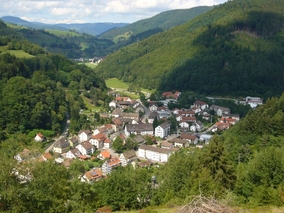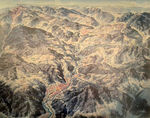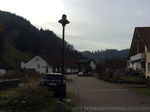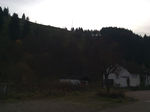Green Infrastructure 2014 Working Group J - Case Study 1
---> back to group page working group J
Schwarzwald-Germany, Negar Mehryar
| Atzenbach valley | name of the site | |
| Germany | country | |
| Schwarzwald, Zell im Wiesental | place | |
| Negar Mehryar | author | |

| ||
|
| ||
Rationale: Why is this case interesting?
Black Forest/Schwarzwald is the overgrown mountain region in the southern part of Baden-Württemberg, Germany and its name is derived from " the dark canopy of evergreens". Black Forest is located on eastern part of the river Rhine between Karlsruhe and Basel (Switzerland), with the length of 150 km and 60 km width.The highest pick of blackforest mountains and also the highest in Germany outside of the Alps is called Feldberg. Zell im Wiesental, is a town in the district of Lörrach, located in the extreme southern part of Black Forest very close to the Swiss border and it is situated on the river Wiese, which rises from Feldberg and it is the right branch of the Rhine. The case site is a village belongs to Zell, called Atzenbach with 3.68 km2, 447 m hight and 782 inhabitants. There is one kindergarten, one primary school and a few small stores in the village, Zell offers more supermarkets in the center. In Atzenbach the population is not increasing rather than specially young people seem to moving to bigger cities to have the benefits of job and social facilities. The economic benefit from local farmers shrinks due to global pressure on food prices. The interesting point is if no new houses or structures supposed not to get built in the area and there would be no activities on the farms, as the hills around the valley are potentially ready to get covered by trees and green infrastructure, what will happen to the valley?
Author's perspective
I am from Iran, Tehran and my Bachelor degree is in Architecture. I studied master of landscape architecture in hfwu Nürtingen-Geislingen, in IMLA program. Now I am living with a German family in the chosen place, Atzenbach where the natural beauty is breathtaking as you see the most ever-green areas in my environment or in autumn the mixture of colorful leaves spreading around gives magnificent scenes. Every day I need to travel to Lörrach to attend an intensive German course and use public transportation system which I found it so accessible and easy to get to the destination although the valley seems neglected. The appropriate bicycle roads along the river Wiese and also upon the hills are so common to use for different purposes, like hiking, biking and get to the center where the supermarkets and some other stores plus restaurants are located. But not more! For me who comes from the crowded metropolitan city, living in this valley is obviously a huge contrast also interesting and at the same time boring. what is your professional/educational background and your relation to the site?
Landscape and/or urban context of your case
Natural features: The entire municipality Zell's is part of the southern Black Forest . In addition, the cell still has interest in two Fauna-Flora-Habitat (FFH) territories: 111.87 acres of the district are part of the conservation area "Weidfelder in the upper meadow valley". For the Black Forest typical cultural landscape of Weidfeldern, beech woods and meadow brooks has a total area of more than 1,700 acres and provides inter alia habitat for bullhead , brook lamprey , Green Fork Teeth moss , Spanish flag and greater mouse-eared . 3.53 hectares of the district are also to FFH "Röttler forest". It is a distributed via multiple communities, more than 2,500 acres of structurally rich woods and fields with Buchenaltbeständen . The fact native species include the yellow-bellied toad , the stag beetle , the helmet-Azurjungfer , the Green Fork Teeth moss , the Bechstein - and the Geoffroy's bat and the greater mouse-eared .A small district piece of 1.71 acres is also part of the SPA " Southern Black Forest "(total 33,515.91 hectares), whose inventory of species including the owl , peregrine falcon , Black Kite , Honey Buzzard and the Zitronengirlitz belong. Also close to Zeller district seven natural monuments. It is the hilltop of "Rümmelesbühl" at Gresgen that Atzenbacher waterfalls Höllwasserfälle Pfaff mountain, the Fischbach waterfalls in cell and three trees: A standalone pasture Linde in "Moosrain" Pfaff mountain, the spruce "Lonely fir "near the High Möhr and a Weidbuche in "Erlenboden" at Gresgen.
History: Cell was probably around the year 1000 as a monk colony or hermitage (cella) of Säckinger Fridolin founded the monastery Säckingen. cell was first documented in 1275 in the tenth book of the diocese of Constance. From the present-day districts Atzenbach and Gresgen were mentioned in documents before cell. Both appear as Atzo and Greszkon in a deed of Walcho of Waldeck on from 1113. The other districts were all mentioned later: Mambach in 1377, Pfaff mountain and Riedichen (together with the Gaisbühl, but without that already in 1396 mentioned Käsern) in Säckinger interest sled of the year 1439. The same also applies to the Adelberg, however, in which a presumably consists of the 13th century, originating residential tower. Zell im Wiesental is famous for being the hometown of Constanze Weber,wife of Wolfgang Amadeus Mozart. and also for its textile industry. In the 1848 revolution the growth of the textile industry. Weaving mills in which the looms were driven by water power. The same year also a foil mill and Bölger Ringwald was established on the site of the former Mont researched Cotton weaving. Four years earlier, in 1849, also a spinning mill was founded in Atzenbach. In the time of increasing industrialization Zell's also fell Baden Revolution of 1848-49. After the end of the Baden revolution did a certain stability, briefly interrupted by the unification wars in which several Zeller had to serve. As part of the Franco-German War while one death was to be deplored. [43] The industry in cell growth during this period on, and it was both a shift in the population, as more and more people in the mountain villages Adelberg, Pfaff mountain and Riedichen moved to Atzenbach and cell, as well as to a general population growth. The population of the urban area grew today 1852-1910 by 58.6% to 6046 inhabitants. The population of the urban core cell growth in the same period by 158.7%, which shows the unevenness of this growth and the attraction of the settled in the valley factories. After World War II, the textile industry Zeller went back to their old production and declined further in the following years due to rationalization measures.
Biogeography, cultural features, overall character, history and dynamics
- Illustrations: maps; sketches; short descriptive analyses
- Illustrations
Analytical drawings
- Please use analytical drawing for visualising the conflicts/potentials of your site
- Analytical Drawings
- Your drawing.jpg
your drawing
- Your drawing.jpg
your drawing
- Your drawing.jpg
your drawing
- Your drawing.jpg
your drawing
Green Infrastructure benefits for this site
Look again at the multiple benefits of green infrastructure - what could be achieved in your site and which are most relevant?
Potential for multifunctionality
Green infrastructure has typically multiple functions. What could be achieved for your site in this respect?
Projective drawings
- How would you like this case to change in the near future? (in 1-2 years)
- you may add a short explanation here
- And how could it look like in 10-15 years?
- you may add a short explanation here
- Projective Drawings
- Yourdrawing.jpg
projective drawing
- Yourdrawing.jpg
projective drawing
- Yourdrawing.jpg
projective drawing
- Yourdrawing.jpg
projective drawing
Summary and conclusion
- 100 words approx.
Image Gallery
Please add further images/photos here
- Image Gallery
- Yourimage.jpg
your image text
- Yourimage.jpg
your image text
- Yourimage.jpg
your image text
- Yourimage.jpg
your image text
- Yourimage.jpg
your image text
- Yourimage.jpg
your image text
- Yourimage.jpg
your image text
- Yourimage.jpg
your image text
References
- please add your references here
About categories: You can add more categories with this tag: "", add your categories


